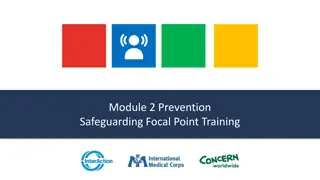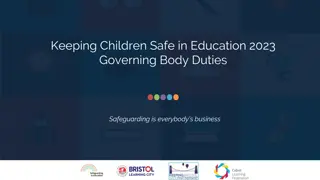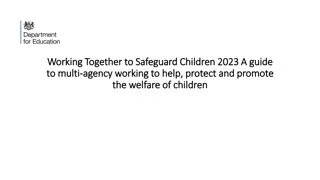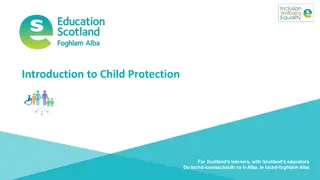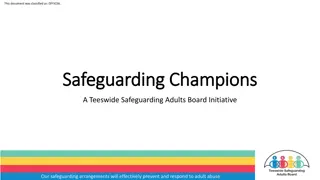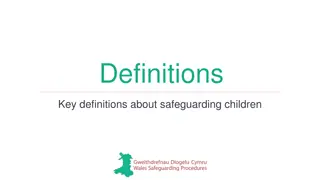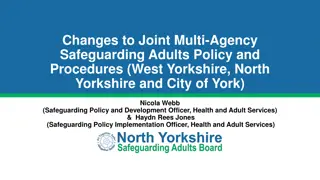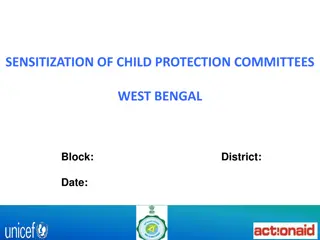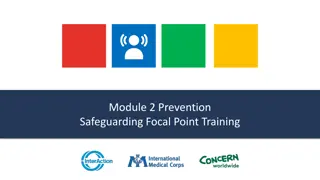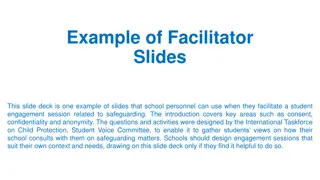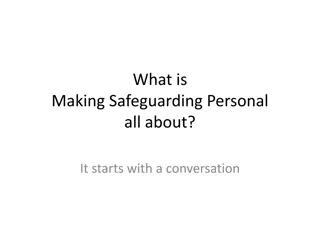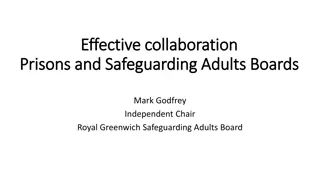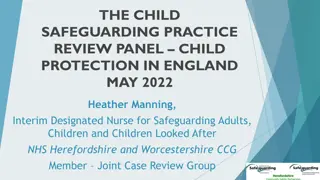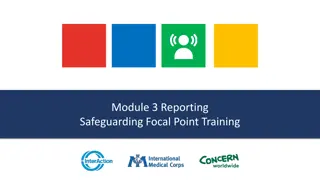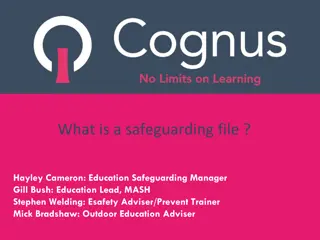Child Protection and Safeguarding Training Overview
This session provides participants with an understanding of safeguarding and child protection in The Boys Brigade context. It covers recognizing, responding to, reporting, and recording concerns about children or young persons. The session explores the importance of safeguarding measures to promote children's welfare and protect them from harm. Legislative acts and guidance related to child protection are also highlighted, enhancing participants' confidence in handling safeguarding referrals.
Download Presentation

Please find below an Image/Link to download the presentation.
The content on the website is provided AS IS for your information and personal use only. It may not be sold, licensed, or shared on other websites without obtaining consent from the author. Download presentation by click this link. If you encounter any issues during the download, it is possible that the publisher has removed the file from their server.
E N D
Presentation Transcript
LEARNING OUTCOMES At the end of this session participants will be able to: Understand Safeguarding and Child Protection in the context of your role within The Boys Brigade Know how to Recognise, Respond to, Report and Record concerns about a child or young person
YOUR SAFEGUARDING TIMELINE When was the last time you did any safeguarding training? In the past six months? In the past year? Ever?
YOUR SAFEGUARDING TIMELINE How confident are you in dealing with a safeguarding referral? Very confident I know the policies, I know what to do and who to inform Fairly confident I know what to do and when but might need help with the process Not very confident I would rather someone else did it Not at all confident I do not know what I would need to do
WHAT IS SAFEGUARDING? Safeguarding is the measures and actions that are taken to promote the welfare of children & young people and protect them from harm.
CHILD PROTECTION WHAT DOES THIS MEAN? This a part of safeguarding. It is the actual action and processes we undertake to protect individual children or young people we suspect have suffered or are suffering harm.
LEGISLATION AND GUIDANCE Child Care Act 1991 Protection for Persons Reporting Child Abuse Act 1998 Criminal Justice Act (reckless endangerment) 2006 Criminal Justice (Withholding of Information on Offence Against Children & Vulnerable Persons) Act 2012
LEGISLATION AND GUIDANCE National Vetting Bureau (Children & Vulnerable Persons) 2012-2016 Criminal Law (Sexual Offences) Act 2017 Domestic Violence Act 2018 Coco s Law (The Harassment, Harmful Communications & Related Offences Act) 2020 Children First Act 2015 (fully commenced 2017, Addendum 2019)
SAFER RECRUITMENT Our Safer Recruitment Policy is about ensuring suitable leaders are appointed through . . . Recommendations Vetting ID Verification References Training
SAFER RECRUITMENT Our safer recruitment policy is about ensuring suitable leaders are appointed through . . . Recommendations Vetting ID Verification References Training
TRAINING & DEVELOPMENT We have a culture of on-going training and development, this includes . . . Mandatory e-learning modules Youth Leader Training (YLT) Refresher & Other Themed Training
POLICIES & GUIDANCE Safeguarding Policy Safer Recruitment Leader Code of Conduct Good Practice Guidance Guidance for Leaders facing safeguarding concerns/allegations Position of Trust Guidance Complaints policy and disciplinary procedures Find online at boysbrigade.ie/safeguarding
WORKING SAFELY WITH CHILDREN SMALL GROUP ACTIVITY
WORKING SAFELY WITH CHILDREN Supervision Ratios Number of Children Number of Adults 1 8 2 9 16 3 17 24 4 25 - 32 5
LEADERS CODE OF CONDUCT Outlines the expectations we have of our leaders in relation to their behaviours and actions, including: Responsibilities Relationships & Boundaries Expected Good Practice Unacceptable Behaviour
PHYSICAL CONTACT Be in response to the need of the child, not the need of the adult. Be with the child s permission, resistance from the child should be respected. Avoid swimsuit areas. Be open and not secretive. Be governed by the age and developmental stage of the child.
RECOGNISING HARM & ABUSE SMALL GROUP ACTIVITY
RECOGNISING HARM & ABUSE Was there a type of harm you were unaware of? Is there anything you would struggle with? Would you feel uncomfortable hearing about some of these? Is there anything you don t understand? Are there any words you might find hard to say when passing it on ?
REASONABLE GROUNDS FOR CONCERN Evidence, for example an injury or behaviour, that is consistent with abuse and is unlikely to have been caused in any other way. Any concern about possible sexual abuse. Consistent signs that a child is suffering from emotional or physical neglect. A child saying or indicating by other means that they have been abused. Admission or indication by an adult or a child of an alleged abuse they committed. An account from a person who saw the child being abused.
HOW PREVALENT IS CHILD ABUSE IN IRELAND? In 2021 over half of child protection and welfare referrals to Tusla were welfare concerns.1 A report from the 2017/18 school year indicated that 1 in 8 primary school children and 1 in almost 7 secondary school children missed 20 days or more of school.2 Report in April 2021 found that children (under 16 years) accounted for 26.1% of all those in poverty.3 During peak Covid restrictions (March 2020 June 2020) Childline answered over 70,000 contacts from children/young people.4
HOW PREVALENT IS CHILD ABUSE IN IRELAND? Over 93% of sexual predators are known to children.5 1 in 5 sexual offences are committed by males under the age of 18 and 1 in 5 sexual offences have been found to involve children as the offender and victim.6 At the end of 2020, 91% of children in care were placed in foster care.7
THE 4 Rs - RECOGNISING SMALL GROUP ACTIVITY: Case Studies In groups consider each statement: On a scale of 1 10 (10 = greatest) rank case study based on how much harm is being caused to the child. Try to reach an agreement about the ranking and note down any reasons if you disagree.
THE 4 Rs Things to consider: Has the child/young person been abused/harmed? What type of harm/abuse is this? Does it meet the reasonable grounds for concern? Has a crime been committed? What are you going to do? Remember to rank each case study on a scale of 1 10 (10 = greatest)
CASE STUDY 1 You are a leader in your Company. One of the young people attends BB with a mark on his face. He tells you his teaching assistant did it at school today. He hasn t told his parents as they were busy earlier, and did not notice the mark.
CASE STUDY 1 The Law Currently Republic of Ireland - On 11th December 2015 the reasonable punishment defence was abolished. (Children First Act 2015)
CASE STUDY 2 You are the Leader-in-Charge for Juniors. A parent has contacted you and stated their child was kicked by a leader last week and they have reported it to the Gardai today. Your Company meets tomorrow night.
CASE STUDY 3 An Anchor always comes to BB late. They often do not have the correct uniform. They look scruffy, and sometimes appear smelly and unwashed. You notice other children make fun of them.
1 in 10 children have experienced neglect NEGLECT Neglect occurs when a child does not receive adequate care or supervision to the extent that the child is harmed physically or developmentally. It is generally defined in terms of an omission of care, where a child s health, development, or welfare is impaired by being deprived of food, clothing, warmth, hygiene, medical care, intellectual stimulation or supervision and safety. Emotional neglect may lead to the child having attachment issues.
CASE STUDY 4 You recently become a leader after helping at your local BB group for a year. You have just completed the YLT Safeguarding Module and realised that some things in your Company are not done correctly. Helpers attend for several weeks/months, before they complete leader registration processes. Leaders often join in football and other contact games. You spoke about the training to your Captain. He explained that we need to see how helpers fit in before they join properly, and some of the rules are ignored because they don t work for our Company.
Everyones responsibility to ensure that our practices and procedures are in place within our Companies. Complaints procedure in place for leaders to raise issues of concern.
CASE STUDY OVERVIEW How hard was it to agree the level of harm? What helps us make a decision? Is there always a correct answer? How do we get it right?
The 4 Rs: RESPONDING React calmly. Listen carefully and attentively. Take the child seriously. Reassure the child that they have taken the right action in talking to you. Do not promise to keep anything secret. Ask questions for clarification only. Do not ask leading questions. Check back with the child that what you have heard is correct and understood.
The 4 Rs: RESPONDING Do not express any opinions about the person about who the allegation is made. Ensure that the child understands the procedures that will follow. Make a written record of the conversation as soon as possible, in as much detail as possible. Treat the information confidentially, subject to the requirements of Children First Guidance and legislation.
BARRIERS TO RESPONDING What might prevent a leader responding appropriately and not reporting an allegation? SMALL GROUP ACTIVITY: Barriers to responding
Report as soon as possible, always within 24 hours Leader/Employee has concerns Report and record THE 4 R s REPORTING (PASS IT ON) Regional Safeguarding Panel Are there reasonable grounds for concern? No Possibly Yes Continue to monitor, support and record action Consult with Tusla Duty Social Worker No Yes Report & Record Refer back to appropriate personnel Tusla / Garda S ochana
Report as soon as possible, always within 24 hours REGIONAL SAFEGUARDING PANEL Name Email Address Mobile Number Landline Number CHAIR Olive Good olivecgood@gmail.com 087 245 1310 01 812 9398 Philip Daley philip@philipdaley.ie 087 205 7320 Debbie Moore debbie.moore@boys-brigade.org.uk 0044 7989 025654 0044 1442 509534
THE 4 Rs - RECORDING You should . . . Write down what was said as soon as possible. Detail who the concern is about, what the concern is and what happened. Use the child/young person s words - include any questions that were asked, and the answers given. As a leader, write down anything you have seen or heard, including details of any witnesses. Include who you have spoken to, when, and include their contact details. Include any history about the child/young person or family that could be relevant. Complete your report as soon as possible after the event.
CAN WE ASK QUESTIONS? Necessary To establish whether or not there is a concern. Non leading Don t suggest an answer. Open Avoid questions that invite only YES or NO answers. Use TED: TELL ME EXPLAIN DESCRIBE
TELL ME WHAT HAPPENED I was on a school trip, at the park and fell off the climbing frame. Miss was amazing. She grabbed me and stopped me landing on the floor. Her nail caught my face. My head would have have exploded if I hit the deck. I pushed a girl over in the play ground. Miss grabbed my arm and dragged me to the time out area. My head banged on the door as we went inside. She was really cross with me. I made the girl cry. Child Child You now have enough information and an understanding of what has happened.
YOUR ACCOUNT I am Leader-in-Charge for Juniors with 1st Anywhere Company. On Monday 15th October we were designing posters for our fundraising event. The young people were at tables in groups of 4. I saw JP had a mark on his face. The mark was across his cheek bone, and under his eye area. It looked red in appearance. I asked him How did that happen He said My teacher did it . I then asked Tell me what happened? . He said I pushed a girl over in the playground. Miss grabbed my arm and dragged me to the time out area. My head banged on the door handle as we went inside. She was really cross with me. I made the girl cry. During the snack break I spoke to the Captain and told him what had happened. He told me he would take responsibility for this. He asked me to make notes of what JP said and asked me to write this account straight away. JP has been with us for 2 years. He lives with his parents and younger brother. He attends Anywhere Primary School. Signed .dated .
ONLINE REPORTING FORM The best way to report a safeguarding concern or allegation is to use our internal reporting form at boysbrigade.ie/safeguarding
YOUR ROLE We can all play a part in keeping children safe. ALWAYS Remember: Safeguarding is everyone s responsibility. The 4 R s Recognise, Respond, Report & Record. Always maintain appropriate boundaries with children & young people. Regularly familiarise yourself with our latest polices and procedures. inform Regional Safeguarding Panel of any safeguarding concern about a BB Volunteer or child as soon as possible, but always within 24 hours. Olive Good Philip Daley Debbie Moore If any doubt, seek advice!
YOUR SAFEGUARDING TIMELINE How confident are you now, in dealing with a safeguarding referral ? Very confident I know the policies, I know what to do and who to inform Fairly confident I know what to do and when but might need help with the process Not very confident I would rather someone else did it Not at all confident I do not know what I would need to do
LEARNING OUTCOMES At the end of this session participants will be able to: Understand Safeguarding and Child Protection in the context of your role within The Boys Brigade Know how to Recognise, Respond to, Report and Record concerns about a child or young person.


